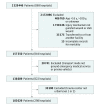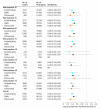Association of Prehospital Mode of Transport With Mortality in Penetrating Trauma: A Trauma System-Level Assessment of Private Vehicle Transportation vs Ground Emergency Medical Services
- PMID: 28975247
- PMCID: PMC5838586
- DOI: 10.1001/jamasurg.2017.3601
Association of Prehospital Mode of Transport With Mortality in Penetrating Trauma: A Trauma System-Level Assessment of Private Vehicle Transportation vs Ground Emergency Medical Services
Abstract
Importance: Time to definitive care following injury is important to the outcomes of trauma patients. Prehospital trauma care is provided based on policies developed by individual trauma systems and is an important component of the care of injured patients. Given a paucity of systems-level trauma research, considerable variability exists in prehospital care policies across trauma systems, potentially affecting patient outcomes.
Objective: To evaluate whether private vehicle prehospital transport confers a survival advantage vs ground emergency medical services (EMS) transport following penetrating injuries in urban trauma systems.
Design, setting, and participants: Retrospective cohort study of data included in the National Trauma Data Bank from January 1, 2010, through December 31, 2012, comprising 298 level 1 and level 2 trauma centers that contribute data to the National Trauma Data Bank that are located within the 100 most populous metropolitan areas in the United States. Of 2 329 446 patients assessed for eligibility, 103 029 were included in this study. All patients were 16 years or older, had a gunshot wound or stab wound, and were transported by ground EMS or private vehicle.
Main outcome and measure: In-hospital mortality.
Results: Of the 2 329 446 records assessed for eligibility, 103 029 individuals at 298 urban level 1 and level 2 trauma centers were included in the analysis. The study population was predominantly male (87.6%), with a mean age of 32.3 years. Among those included, 47.9% were black, 26.3% were white, and 18.4% were Hispanic. Following risk adjustment, individuals with penetrating injuries transported by private vehicle were less likely to die than patients transported by ground EMS (odds ratio [OR], 0.38; 95% CI, 0.31-0.47). This association remained statistically significant on stratified analysis of the gunshot wound (OR, 0.45; 95% CI, 0.36-0.56) and stab wound (OR, 0.32; 95% CI, 0.20-0.52) subgroups.
Conclusions and relevance: Private vehicle transport is associated with a significantly lower likelihood of death when compared with ground EMS transport for individuals with gunshot wounds and stab wounds in urban US trauma systems. System-level evidence such as this can be a valuable tool for those responsible for developing and implementing policies at the trauma system level.
Conflict of interest statement
Figures



Comment in
-
Questioning the Benefits of Private Vehicle Transportation vs Emergency Medical Services Transportation.JAMA Surg. 2018 Jun 1;153(6):595-596. doi: 10.1001/jamasurg.2018.0096. JAMA Surg. 2018. PMID: 29541760 No abstract available.
-
Dangers of Private Vehicle Transportation vs Emergency Medical Services Transportation-Reply.JAMA Surg. 2018 Jun 1;153(6):596-597. doi: 10.1001/jamasurg.2018.0111. JAMA Surg. 2018. PMID: 29541762 No abstract available.
-
Questioning the Benefits of Private Vehicle Transportation vs Emergency Medical Services Transportation.JAMA Surg. 2018 Jun 1;153(6):596. doi: 10.1001/jamasurg.2018.0108. JAMA Surg. 2018. PMID: 29541775 No abstract available.
Similar articles
-
Police transport versus ground EMS: A trauma system-level evaluation of prehospital care policies and their effect on clinical outcomes.J Trauma Acute Care Surg. 2016 Nov;81(5):931-935. doi: 10.1097/TA.0000000000001228. J Trauma Acute Care Surg. 2016. PMID: 27537514
-
Increased mortality associated with EMS transport of gunshot wound victims when compared to private vehicle transport.Injury. 2014 Sep;45(9):1320-6. doi: 10.1016/j.injury.2014.05.032. Epub 2014 Jun 5. Injury. 2014. PMID: 24957424
-
An Eastern Association for the Surgery of Trauma multicenter trial examining prehospital procedures in penetrating trauma patients.J Trauma Acute Care Surg. 2021 Jul 1;91(1):130-140. doi: 10.1097/TA.0000000000003151. J Trauma Acute Care Surg. 2021. PMID: 33675330 Free PMC article.
-
The effect of transport mode on mortality following isolated penetrating torso Trauma.Am J Surg. 2023 Oct;226(4):542-547. doi: 10.1016/j.amjsurg.2023.06.033. Epub 2023 Jun 29. Am J Surg. 2023. PMID: 37453802 Free PMC article. Review.
-
The prehospital management of ambulance-attended adults who fell: A scoping review.Australas Emerg Care. 2023 Mar;26(1):45-53. doi: 10.1016/j.auec.2022.07.006. Epub 2022 Jul 29. Australas Emerg Care. 2023. PMID: 35909044
Cited by
-
Traumatic Brain Injury Cases' Mortality Predictors, Association, and Outcomes in the Emergency Department at a Tertiary Healthcare Center in Saudi Arabia.Asian J Neurosurg. 2022 Sep 9;17(3):416-422. doi: 10.1055/s-0042-1750786. eCollection 2022 Sep. Asian J Neurosurg. 2022. PMID: 36398167 Free PMC article.
-
Association of Prehospital Plasma Transfusion With Survival in Trauma Patients With Hemorrhagic Shock When Transport Times Are Longer Than 20 Minutes: A Post Hoc Analysis of the PAMPer and COMBAT Clinical Trials.JAMA Surg. 2020 Feb 1;155(2):e195085. doi: 10.1001/jamasurg.2019.5085. Epub 2020 Feb 19. JAMA Surg. 2020. PMID: 31851290 Free PMC article. Clinical Trial.
-
Prehospital transportation of severe penetrating trauma victims in Sweden during the past decade: a police business?Scand J Trauma Resusc Emerg Med. 2023 Sep 8;31(1):45. doi: 10.1186/s13049-023-01112-x. Scand J Trauma Resusc Emerg Med. 2023. PMID: 37684674 Free PMC article.
-
Patterns of pediatric thoracic penetrating injuries: A single-trauma-center experience in Riyadh, Saudi Arabia.Saudi Med J. 2021 Mar;42(3):280-283. doi: 10.15537/smj.2021.42.3.20200693. Saudi Med J. 2021. PMID: 33632906 Free PMC article.
-
[Indicators to measure the performance of emergency trauma care].Rev Med Inst Mex Seguro Soc. 2023 Nov 6;61(6):819-840. doi: 10.5281/zenodo.10064412. Rev Med Inst Mex Seguro Soc. 2023. PMID: 37995348 Free PMC article. Review. Spanish.
References
-
- Gervin AS, Fischer RP. The importance of prompt transport of salvage of patients with penetrating heart wounds. J Trauma. 1982;22(6):443-448. - PubMed
-
- Feero S, Hedges JR, Simmons E, Irwin L. Does out-of-hospital EMS time affect trauma survival? Am J Emerg Med. 1995;13(2):133-135. - PubMed
-
- West JG, Trunkey DD, Lim RC. Systems of trauma care: a study of two counties. Arch Surg. 1979;114(4):455-460. - PubMed
-
- Cales RH. Trauma mortality in Orange County: the effect of implementation of a regional trauma system. Ann Emerg Med. 1984;13(1):1-10. - PubMed
MeSH terms
LinkOut - more resources
Full Text Sources
Other Literature Sources

